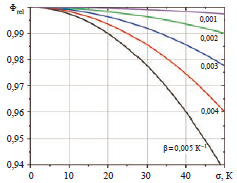Вплив температурних умов експлуатації світлодіодних модулів на їхні електрооптичні та експлуатаційні параметри
Анотація
Розглянуто вплив наявності у світлодіодному модулі відмінностей між температурами окремих світлодіодів на світловий потік та термін його служби. Визначено, що при оцінці ефективності та довговічності світлодіодних модулів необхідно враховувати стандартне відхилення температури світлодіодів від середнього значення. Продемонстровано, що при стандартному відхиленні температури на 20°C відносне зниження світлового потоку модуля може становити близько 1%, а кожне підвищення градієнта температури на 10°C — зменшити строк його служби більше ніж у три рази.
Посилання
Weisbuch C. Review — On the search for efficient solid state light emitters: past, present, future. ECS Journal of Solid State Science and Technology, 2020, vol. 9, no. 1, 016022. https://doi.org/10.1149/2.0392001jss
Bhattarai T., Ebong A., Raja M. A review of light-emitting diodes and ultraviolet light-emitting diodes and their applications. Photonics, 2024, vol. 11, no. 6, 491. https://doi.org/10.3390/photonics11060491
Pekur D. V., Sorokin V. M. State of the art and prospects for the evolution of white LEDs with near natural light emission. Optoelectronics and Semiconductor Technique, 2023, vol. 58, рр. 16 – 20. https://doi.org/10.15407/iopt.2023.58.016 (Ukr)
Barbosa J. L. F., Coimbra A. P., Simon D., Calixto W. P. Optimization process applied in the thermal and luminous design of high power LED luminaires. Energies, 2022, vol. 15, iss. 20, 7679. https://doi.org/10.3390/en15207679
Różowicz A., Wachta H., Baran K. et al. Arrangement of LEDs and their impact on thermal operating conditions in high-power luminaires. Energies, 2022, vol. 15, iss. 21, 8142. https://doi.org/10.3390/en15218142
Chinchero H. F., Alonso J. M., Hugo O. T. A review on smart LED lighting systems. 2020 IEEE Green Energy and Smart Systems Conference (IGESSC), Long Beach, CA, USA, 2020, pp. 1 – 6. https://doi.org/10.1109/igessc50231.2020.9285004
Taki T., Strassburg M. Review—Visible LEDs: more than efficient light. ECS Journal of Solid State Science and Technology, 2019, vol. 9, no. 1, 015017. https://doi.org/10.1149/2. 0402001jss
Tan L., Liu P., She C. et al. Research on heat dissipation of multi-chip LED filament package. Micromachines, 2021, vol. 13, iss. 1, 77. https://doi.org/10.3390/mi13010077
Cengiz C., Azarifar M., Arik M. A critical review on the junction temperature measurement of light emitting diodes. Micromachines, 2022. vol. 13, iss. 10, 1615. https://doi.org/10.3390/mi13101615
Li Y., Yang Y., Zheng H. et al. Review of high power phosphor-converted light-emitting diodes. 2019 16th China International Forum on Solid State Lighting & 2019 International Forum on Wide Bandgap Semiconductors China (SSLChina: IFWS), Shenzhen, China, 2019, pp. 111 – 115. https://doi.org/10.1109/sslchinaifws49075.2019.9019776
Tan K.-Z., Lee S.-K., Low H.-C. LED Lifetime prediction under thermal-electrical stress. IEEE Transactions on Device and Materials Reliability, 2021, vol. 21, no. 3, pp. 310–319. https://doi.org/10.1109/tdmr.2021.3085579
Padmasali A. N., Kini S. G. Accelerated degradation test investigation for life-time performance analysis of LED luminaires. IEEE Transactions on Components Packaging and Manufacturing Technology, 2019, vol. 10, iss. 4, pp. 551 – 558. https://doi.org/10.1109/tcpmt.2019.2958852
Padmasali A. N., Kini S. G. A generalized methodology for predicting the lifetime performance of LED luminaire. IEEE Transactions on Electron Devices, 2020, vol. 67, iss. 7, pp. 2831 – 2836. https://doi.org/10.1109/ted.2020.2996190
Luo W., Kramer R., Kompier M. et al. Effects of correlated color temperature of light on thermal comfort, thermophysiology and cognitive performance. Building and Environment, 2022, vol. 231, 109944. https://doi.org/10.1016/j.buildenv.2022.109944
Beliakova I., Kostyk L., Maruschak P. et al. The temperature dependence of the parameters of LED light source control devices powered by pulsed voltage. Applied Sciences, 2024, vol. 14, iss. 13, 5678. https://doi.org/10.3390/app14135678
Quispe M. R., Oscco F. M. A., Horn M. J., Gómez M. M. Influence of the temperature of a white LED on its lighting characteristics. Journal of Physics Conference Series, 2023, vol. 2538, 012009. https://doi.org/10.1088/1742-6596/2538/1/012009
Peng D. S., Liu K. L. Effect of ambient temperature and heating time on high-power LED. Journal of Physics: Conference Series, 2021, vol. 1777, 012033. https://doi.org/10.1088/1742-6596/1777/1/012033
Yuan N. F., Pan N. K., Guo N. Y., Chen N. S. Study on thermal degradation of high power LEDs during high temperature and electrical aging. 2013 10th China International Forum on Solid State Lighting (ChinaSSL), Beijing, 2013, vol. 48, pp. 150 – 153. https://doi.org/10.1109/sslchina.2013.7177336

Авторське право (c) 2024 Демид Пекур, Анастасія Міняйло, Ілона Пекур, Віктор Сорокін

Ця робота ліцензується відповідно до Creative Commons Attribution 4.0 International License.
